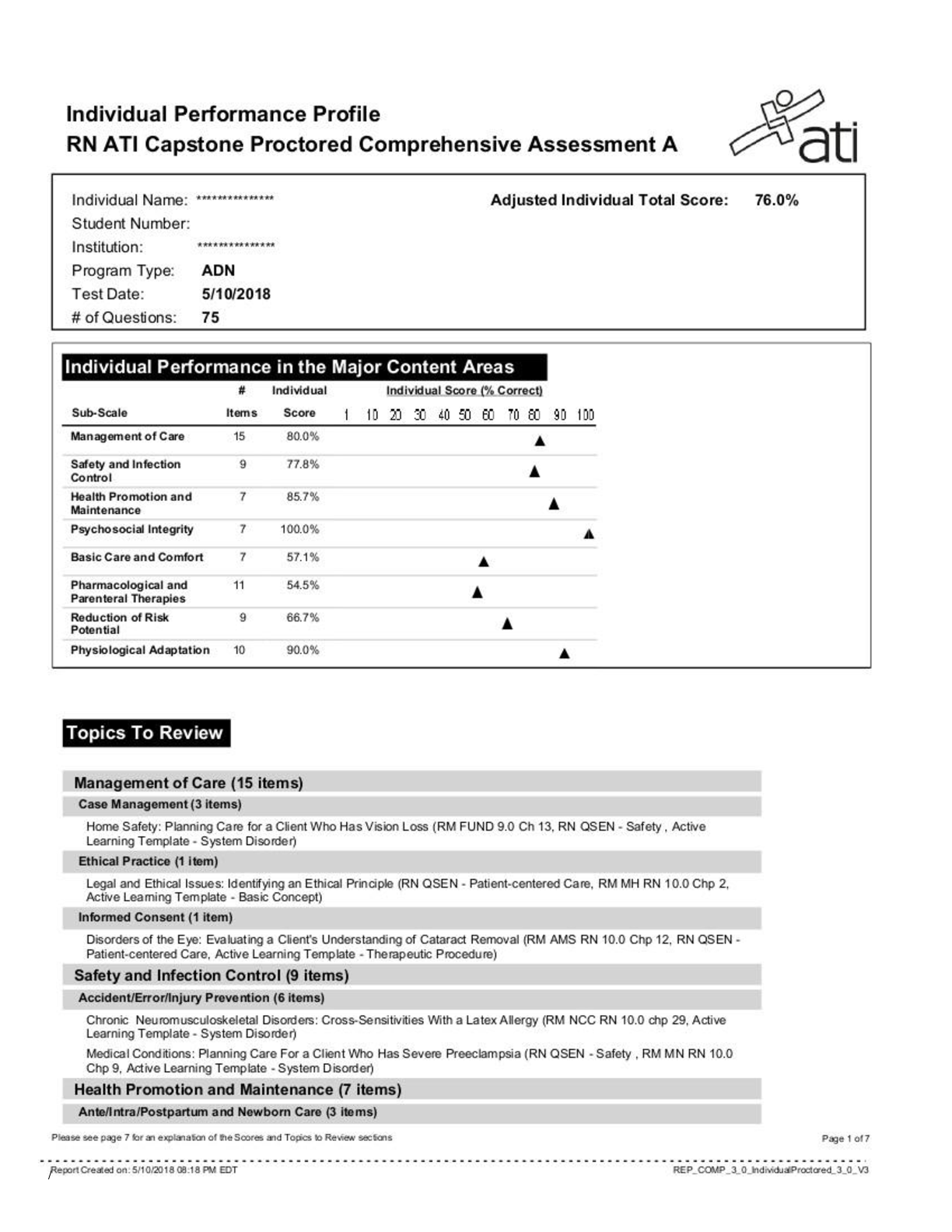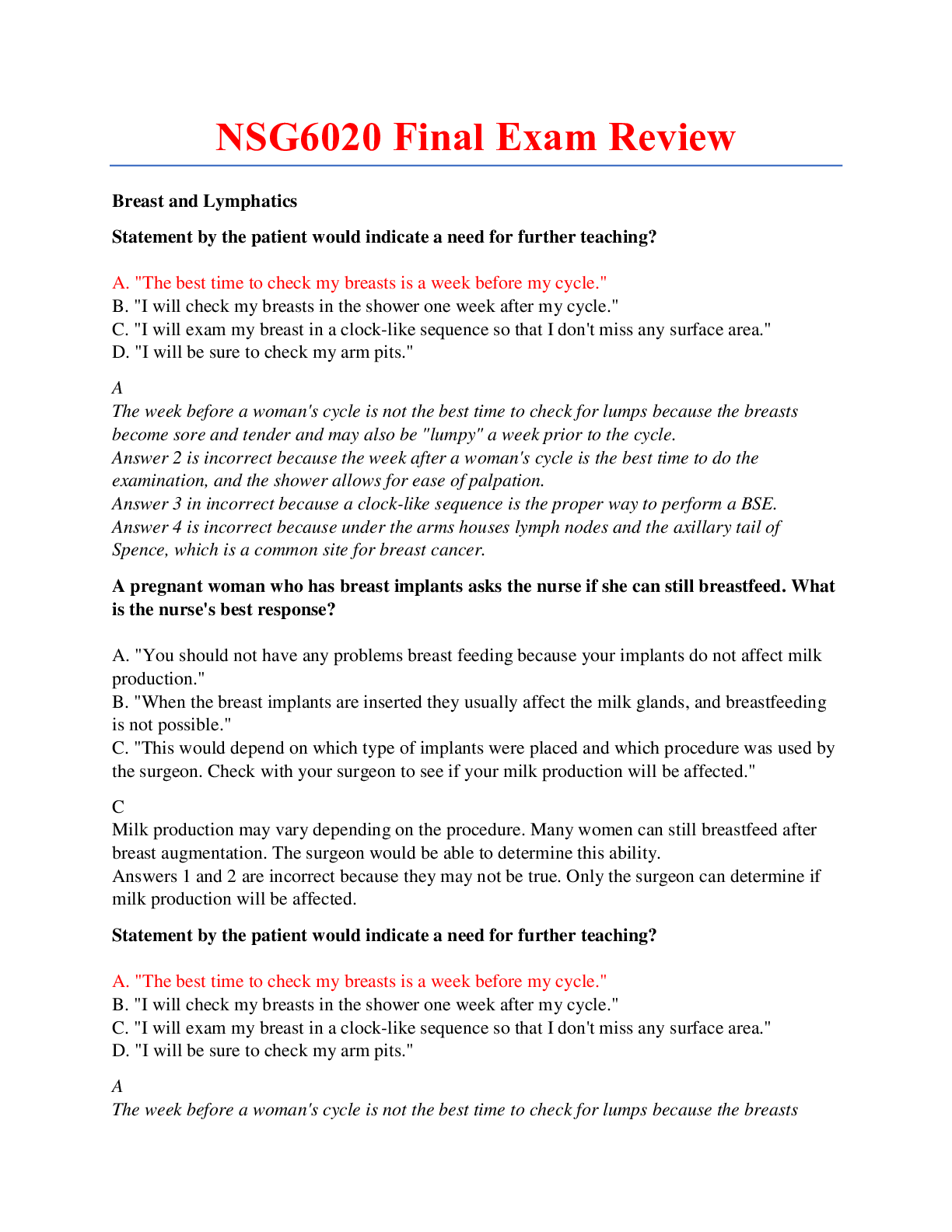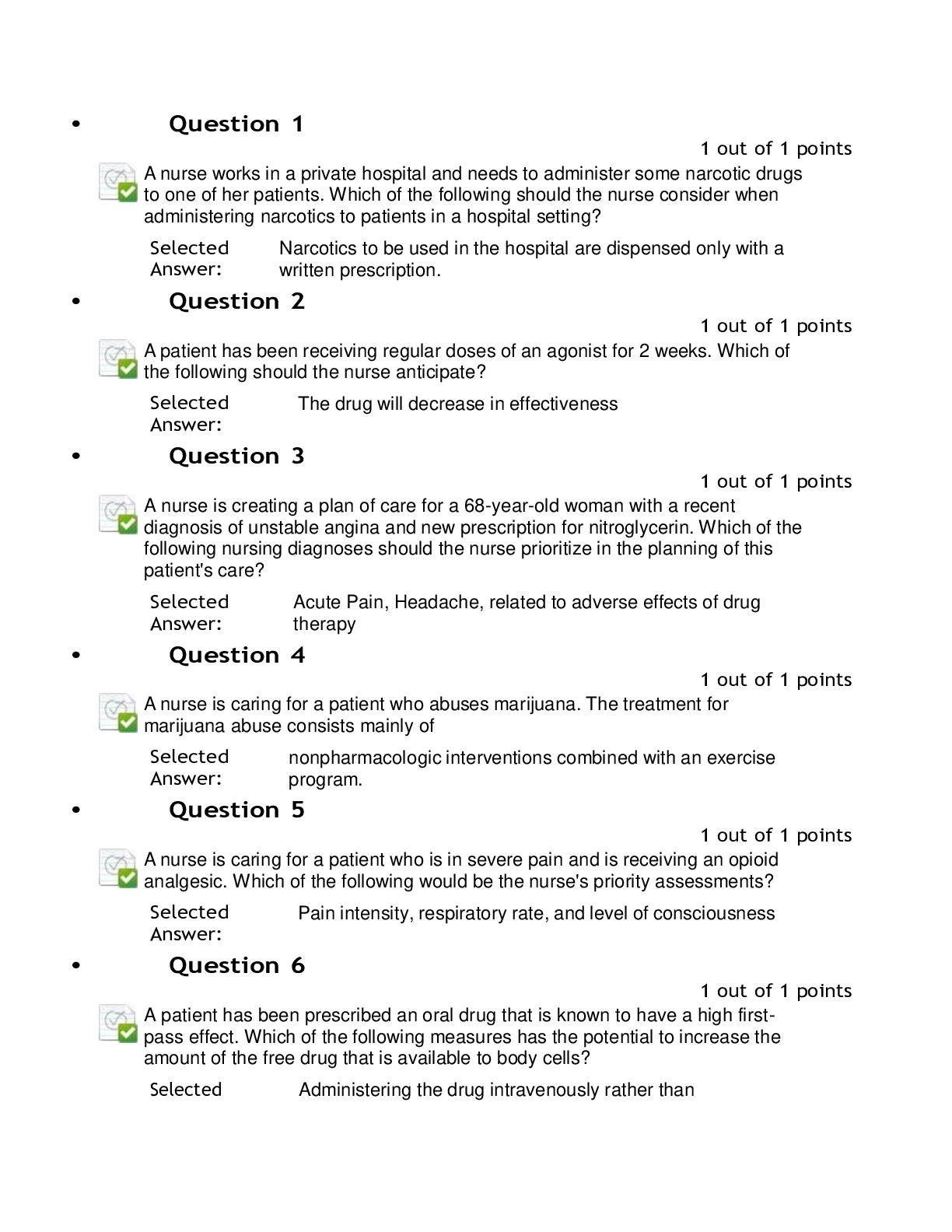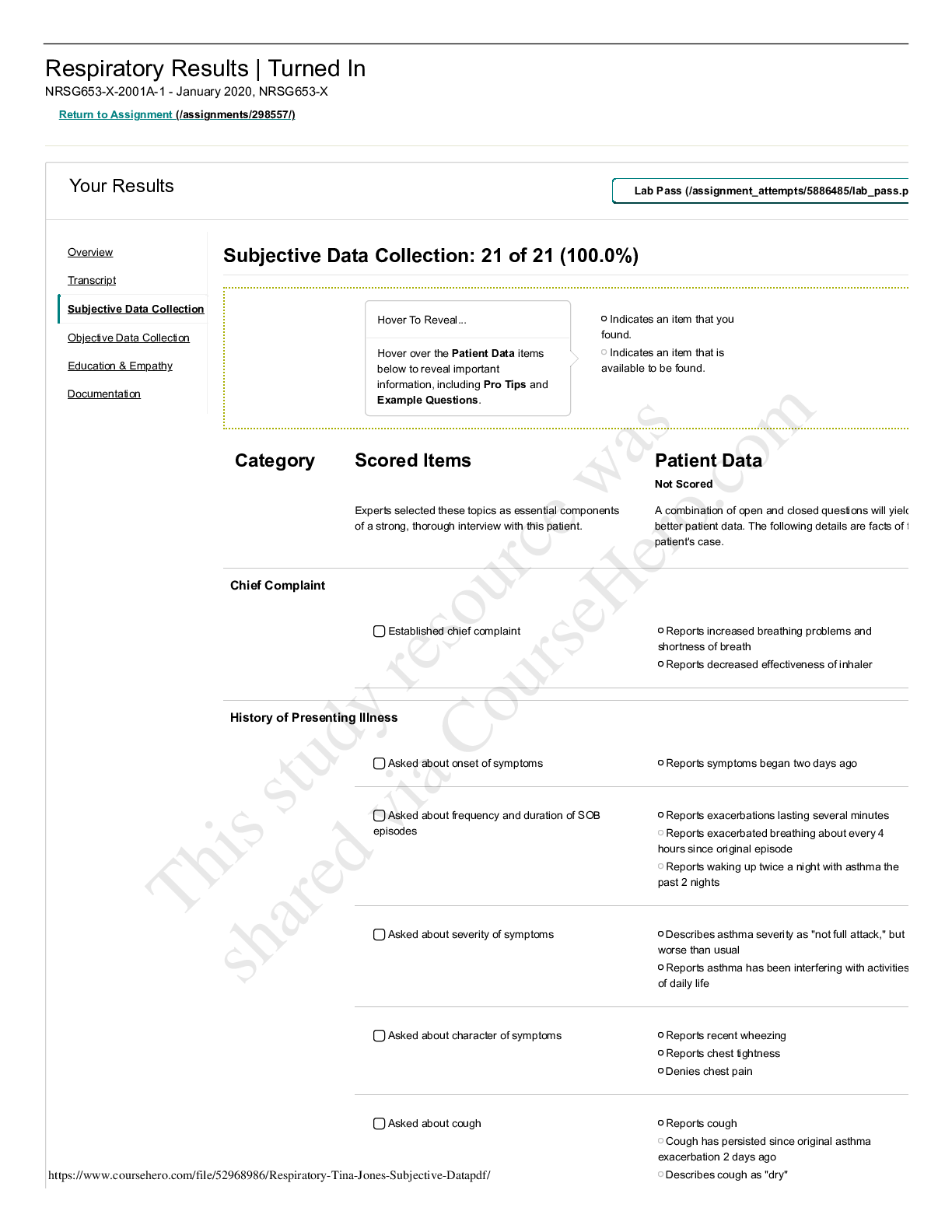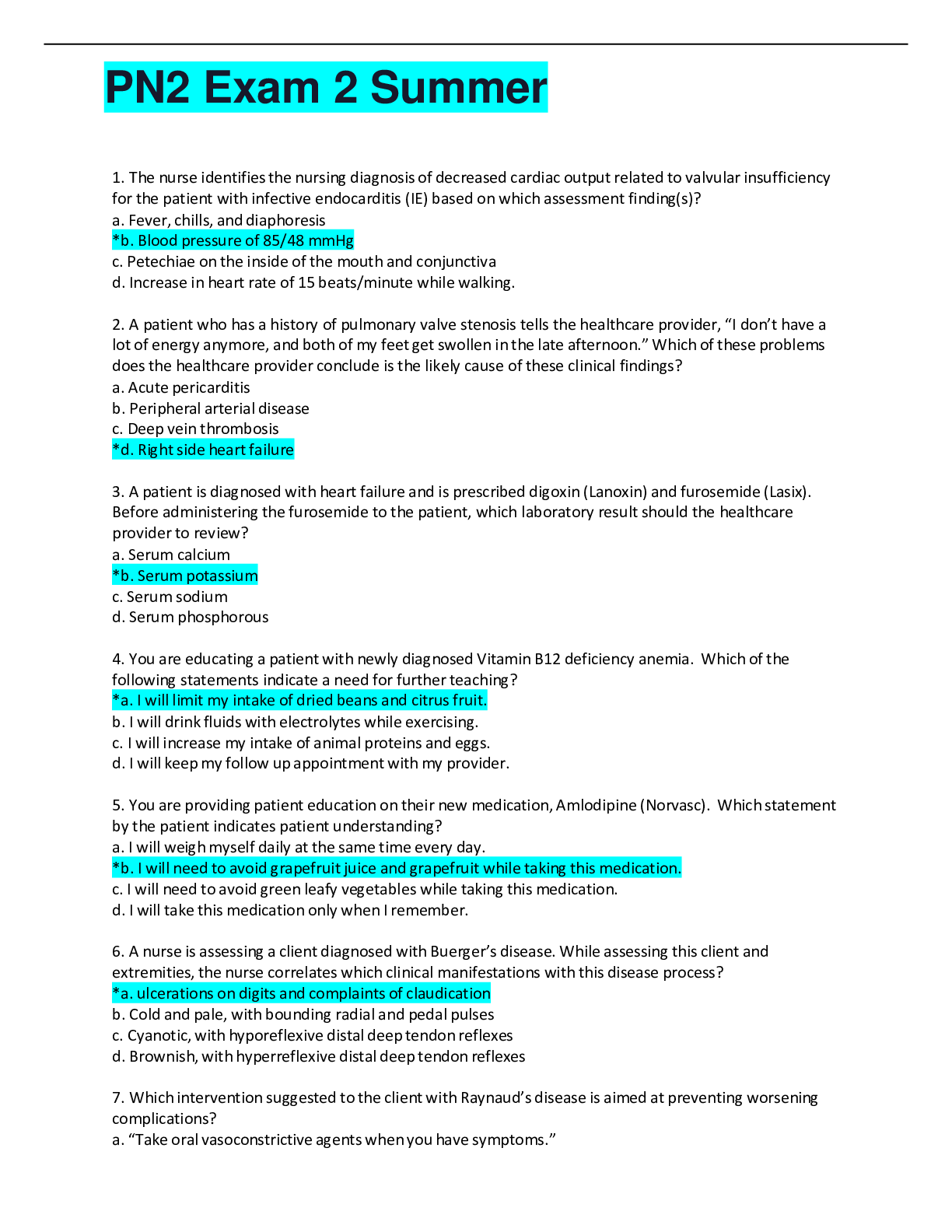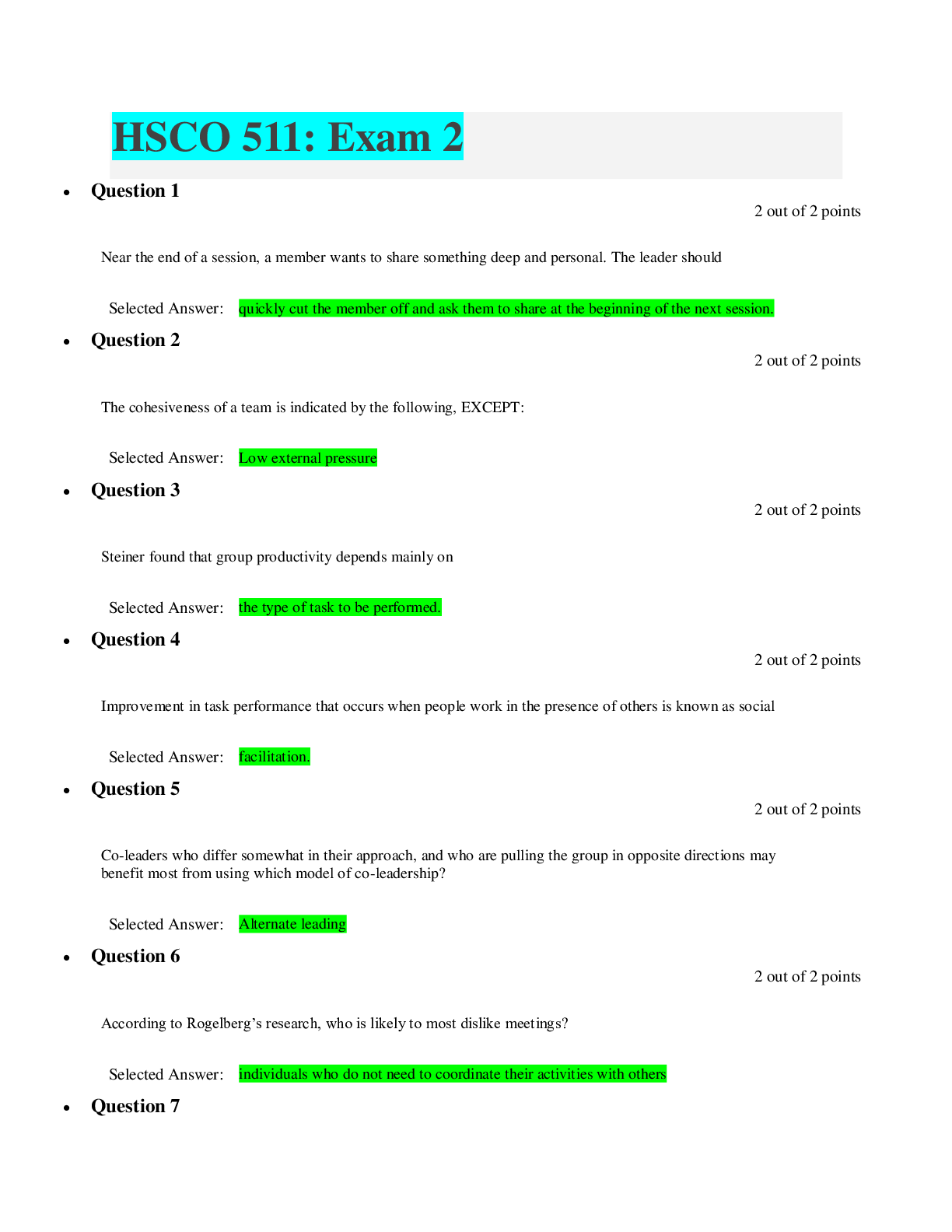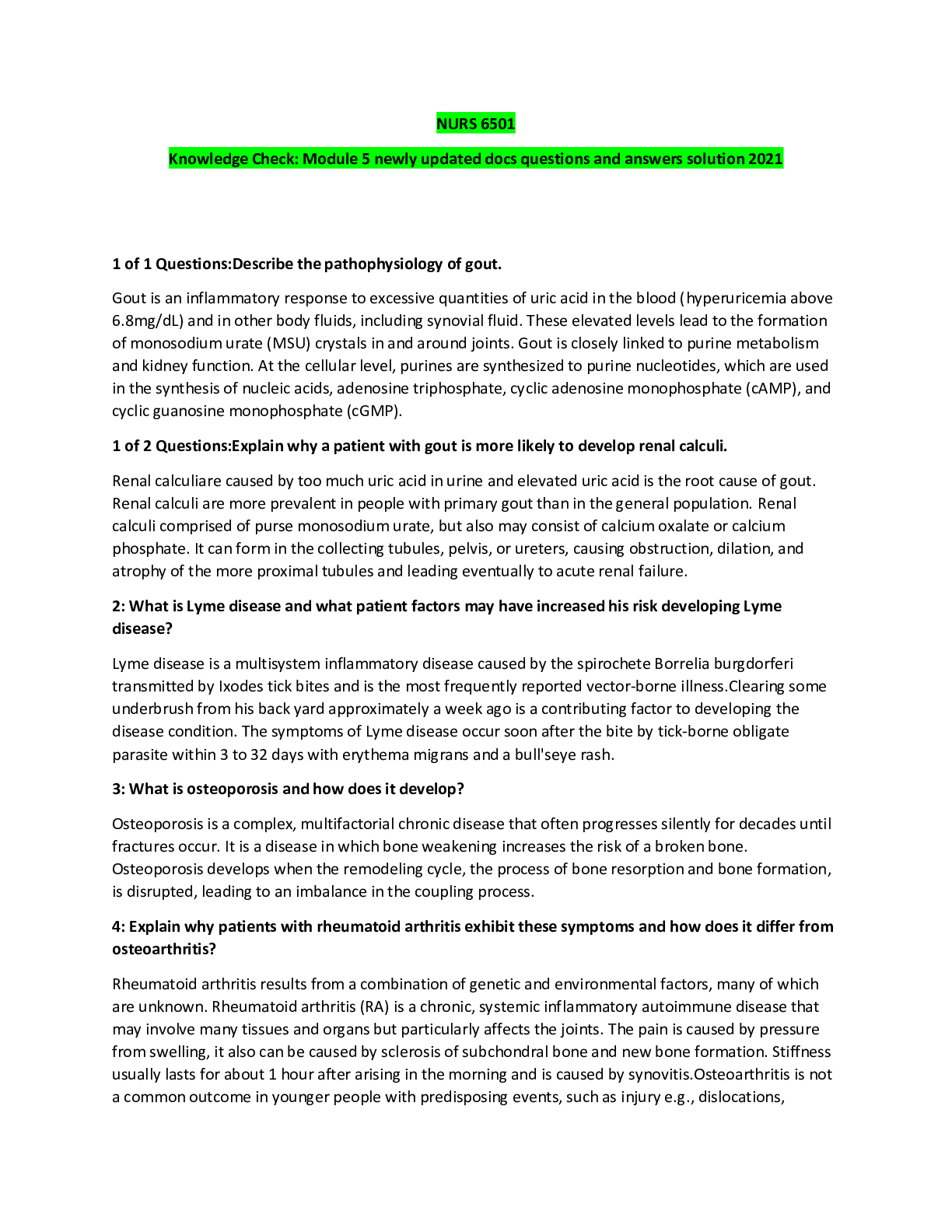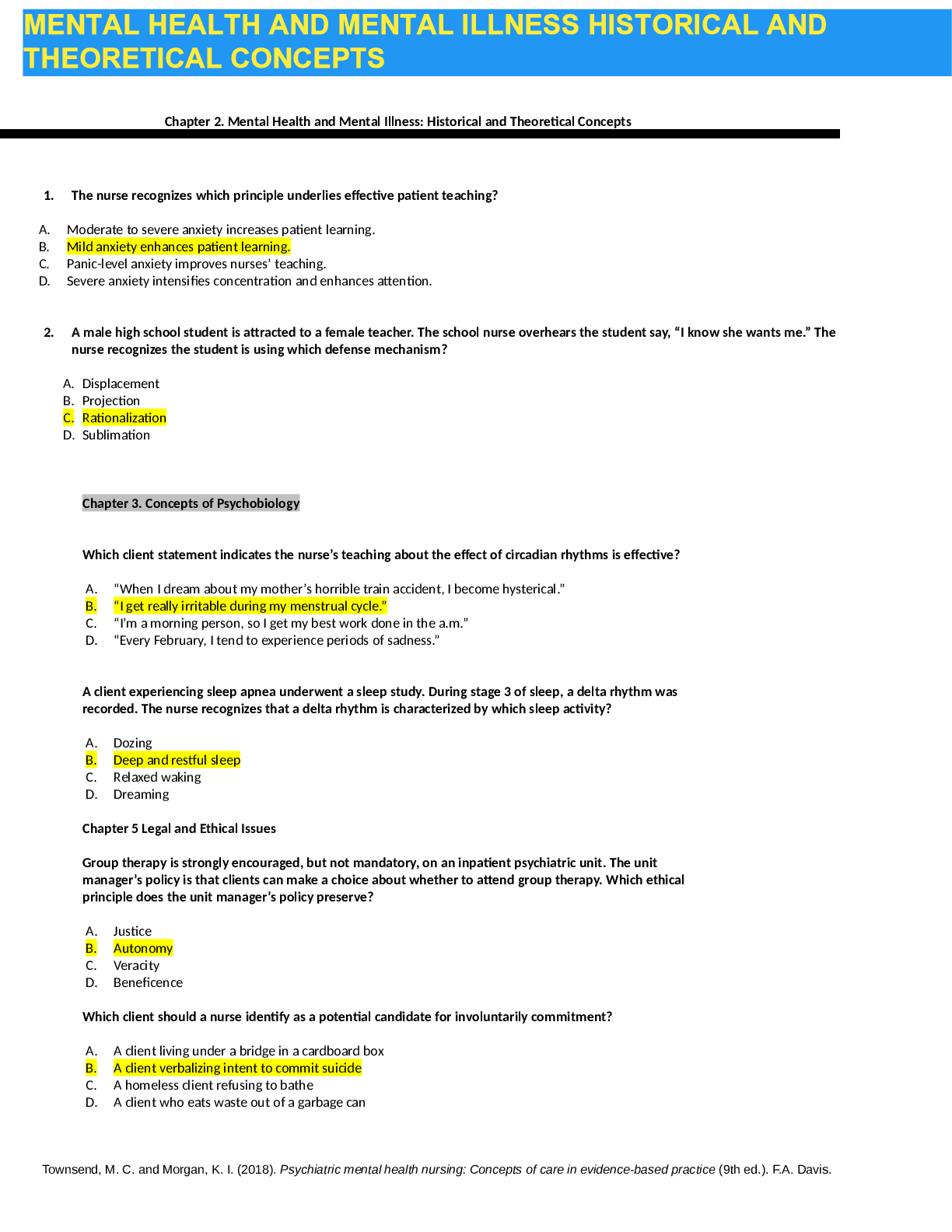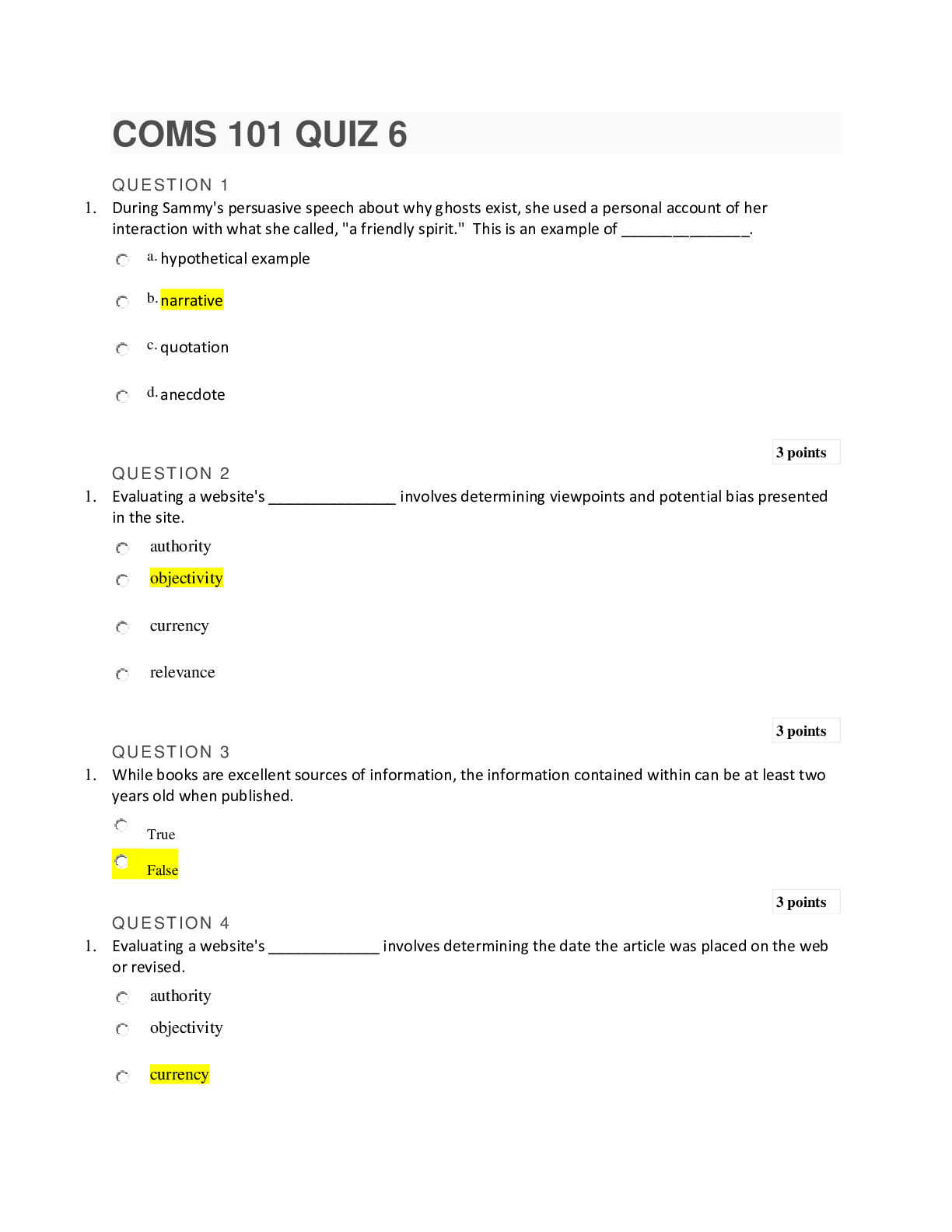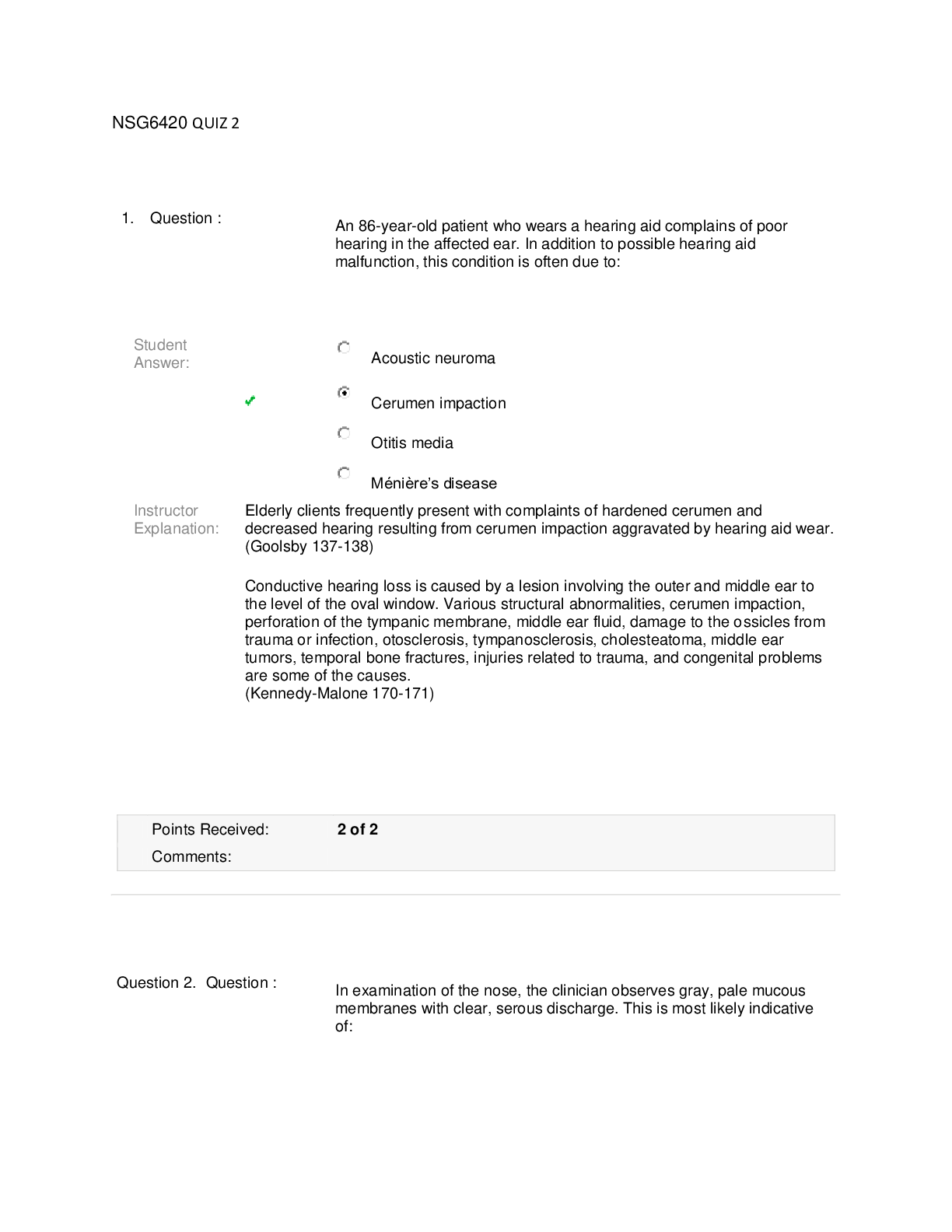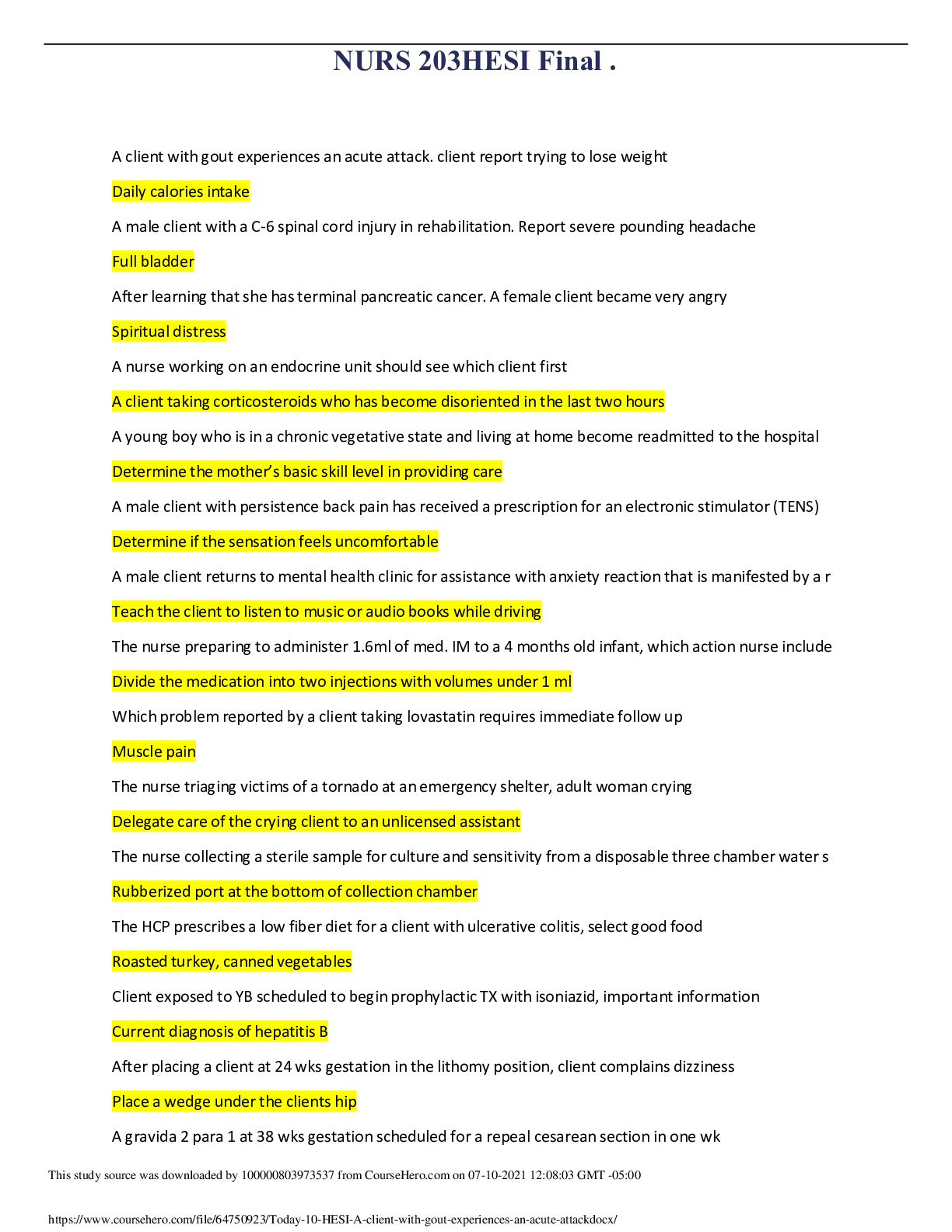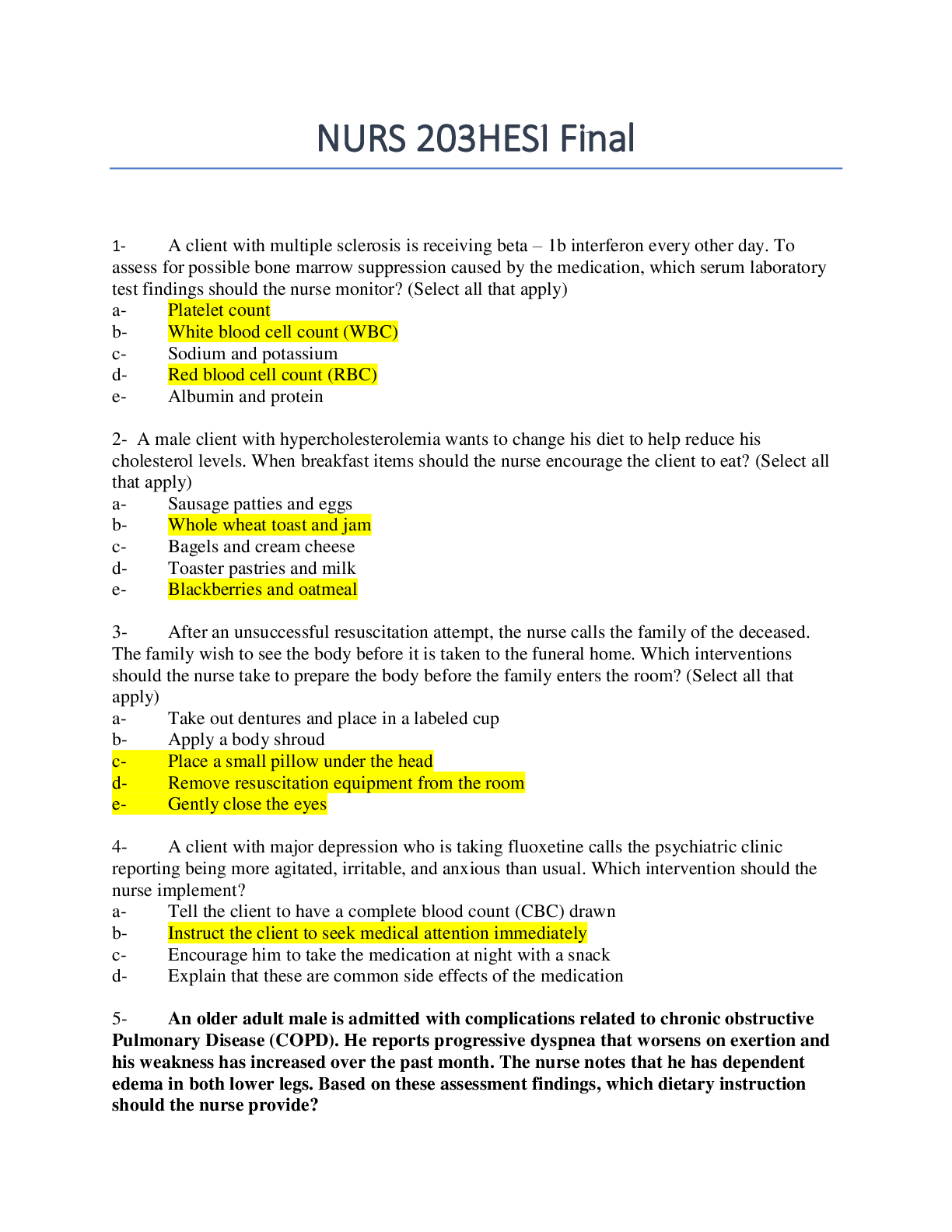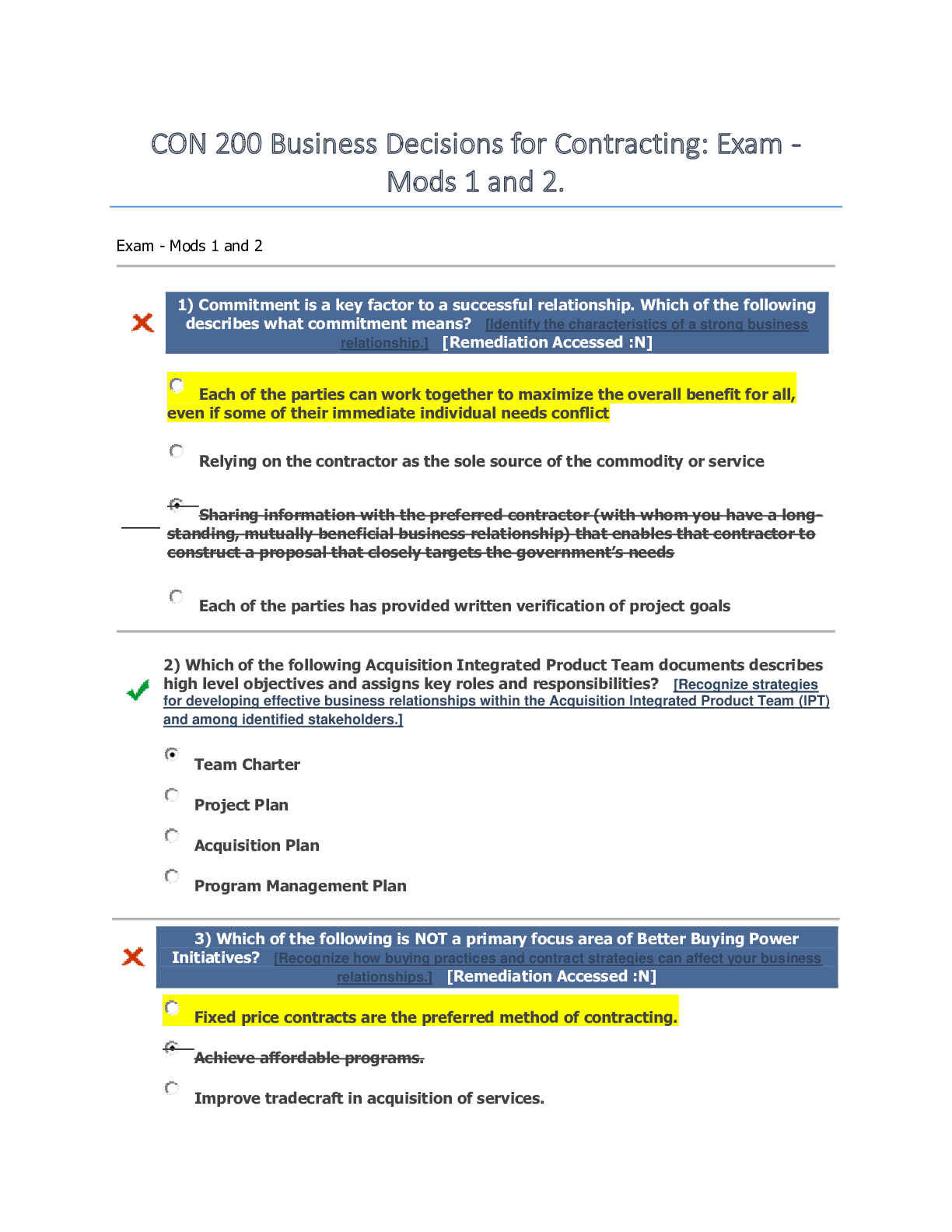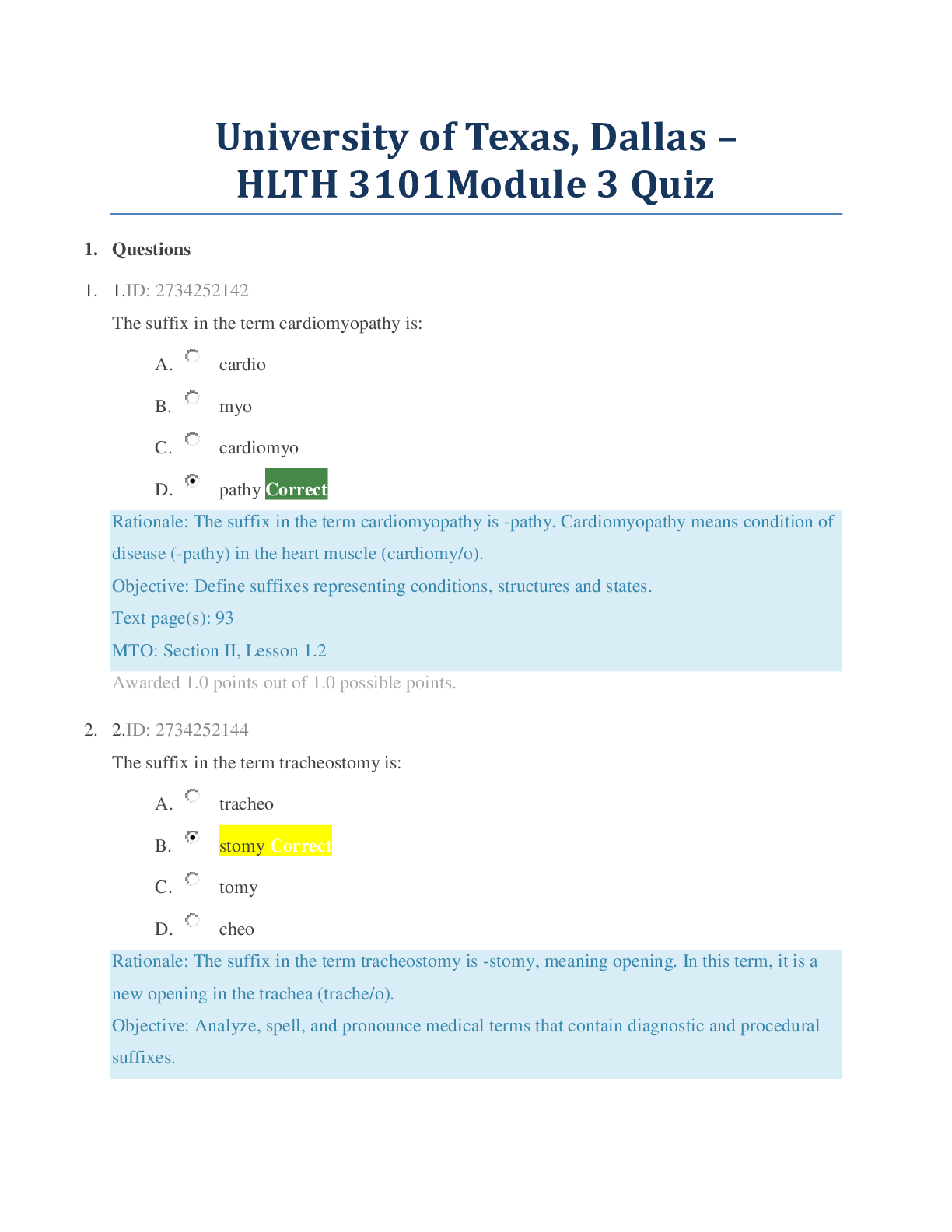NSG 6020 Week 5 Midterm. South University, Savannah All Answers Correct
Document Content and Description Below
NURSING NSG6020week 5 Quiz/Midterm 1. A patient tells the nurse that she has had abdominal pain for the past week. What would be the best response by the nurse? 1. “Can you point to where it hurt... s?” 2. “We’ll talk more about that later in the interview.” 3. “What have you had to eat in the last 24 hours?” 4. “Have you ever had any surgeries on your abdomen?” A final summary of any symptom the person has should include, along with seven other critical characteristics, “Location: specific.” Ask the person to point to the location. 2. A patient’s laboratory data reveal an elevated thyroxine level. The nurse would proceed with anexamination of the: 3. A 6-month-old infant has been brought to the well-child clinic for a check-up. She is currently sleeping. What should the examiner do first? 4. When preparing to examine a 6-year-old child, which action is most appropriate? Start with the thorax, abdomen, and genitalia before examining the head. Keep in mind that a child this age will have a sense of modesty. Have the child undress from the waist up. 5. 68-year-old woman is in the eye clinic for a checkup. She tells the nurse that she has been having trouble with reading the paper, sewing, and even seeing the faces of her grandchildren. On examination, the nurse notes that she has some loss of central vision but her peripheral vision is normal. These findings suggest that: she may have macular degeneration 6. In assessing a patient’s major risk factors for heart disease, which would the nurse want to include when taking a history? 1.Family history, hypertension, stress, age 2.Personality type, high cholesterol, diabetes, smoking 3.Smoking, hypertension, obesity, diabetes, high cholesterol 4.Alcohol consumption, obesity, diabetes, stress, high cholesterol For major risk factors for coronary artery disease, collect data regarding elevated serum cholesterol, elevated blood pressure, blood glucose levels above 130 mg/dl or known diabetes mellitus, obesity, cigarette smoking, low activity level. 7. A teenage patient comes to the emergency department with complaints of an inability to breathe and a sharp pain in the left side of his chest. The assessment findings include cyanosis, tachypnea, tracheal deviation to the right, decreased tactile fremitus on the left, hyperresonance on the left, and decreased breath sounds on the left. The nurse interprets that these assessment findings are consistent with: 8. During a hearing assessment the nurse practitioner finds that sound lateralizes to the patient’s left ear with the Weber test. What can the nurse practitioner conclude from this? The patient has a conductive hearing loss in the right ear. Lateralization is a normal finding with the Weber test. The patient could have either a sensorineural or a conductive loss. A mistake has occurred; the test must be repeated. 9. The most important reason to share information and offer brief teaching while performing the physical examination is to help: 1.the examiner feel more comfortable and gain control of the situation. 2.build rapport and increase the patient’s confidence in the examiner. 3.the patient understand his or her disease process and treatment modalities. 4.the patient identify questions about his or her disease and potential areas of patient education. 10. In assessing the sclera of a black patient, which of the following would be an expected finding? 11. During an examination, the nurse knows that the best way to palpate the lymph nodes in the neck is described by which statement? Using gentle pressure, palpate with both hands to compare the two sides. 12. The nurse is obtaining a history from a 30-year-old male patient and is concerned about health promotion activities. Which of the following questions would be appropriate to use to assess health promotion activities for this patient? 1. “Do you perform testicular self-exams?” 2. “Have you ever noticed any pain in your testicles?” 3. “Have you had any problems with passing your urine?” 4. “Do you have any history of sexually transmitted disease?” Health promotion for a man would include performance of testicular self-examination. 13. When examining a 16-year-old male teenager, the examiner should: provide feedback that his body is developing normally and discuss the wide variation among teenagers on the rate of growth and development. 14. Which of the following statements regarding the aging adult and abdominal assessment is true? 15. In recording the childhood illnesses of a patient who denies having had any, which of the following notes by the nurse would be most accurate? 1. Patient denies usual childhood illnesses. 2. Patient states he was a “very healthy” child. 3. Patient states sister had measles, but he didn’t. 4. Patient denies measles, mumps, rubella, chickenpox, pertussis, or strep throat. Childhood illnesses include measles, mumps, rubella, chickenpox, pertussis, and strep throat. Avoid recording “usual childhood illnesses” because an illness common in the person’s childhood may be unusual today (e.g., measles). 16. A patient's thyroid is enlarged, and the nurse is preparing to auscultate the thyroid for the presence of a bruit. A bruit is a: 17. During an examination, the nurse knows that Paget’s disease would be indicated by which of the following findings? Paget's disease occurs more often in males and is characterized by bowed, long bones, sudden fractures, and enlarging skull bones that press on cranial nerves causing symptoms of headache, vertigo, tinnitus, and progressive deafness. 18. A patient is unable to read the 20/100 line on the Snellen chart. The nurse practitioner would 19. Which technique of assessment is used to determine the presence of crepitus, swelling, and pulsations? 20. During a cardiac assessment on an adult patient in the hospital for “chest pain,” the nurse finds the following: jugular vein pulsations 4 cm above sternal angle when he is elevated at 45 degrees, BP 98/60, HR 130; ankle edema; difficulty in breathing when supine; and an S3 on auscultation. Which of the following best explains the cause of these findings? 1.Fluid overload 2.Atrial septal defect 3.Myocardial infarction 4.Heart failure ANS: 4 Heart failure causes decreased cardiac output when the heart fails as a pump and the circulation becomes backed up and congested. Signs and symptoms: dyspnea, orthopnea, paroxysmal nocturnal dyspnea, decreased blood pressure, dependent, pitting edema; anxiety; confusion; jugular vein distention; fatigue. The S3 may be the earliest sign of heart failure. 21. Primary muscles of respiration include: 22. A patient comes into the clinic complaining of pain in her right eye. On examination, the nurse sees a pustule at the lid margin that is painful to touch, red, and swollen. The nurse recognizes that this is 23. During an examination of a patient’s abdomen, the nurse practitioner notes that the abdomen is rounded and firm to the touch. During percussion, the nurse practitioner notes a drum-like quality of the sound across the quadrants. This type of sound indicates: constipation. air-filled areas. the presence of a tumor. the presence of dense organs. 24. In preforming auscultation of heart sunds, which sequence would the nurse use? 25. A patient comes into the emergency department after an accident at work. A machine blew dust into his eyes and he was not wearing safety glasses. The nurse examines his corneas by shining a light from the side across the cornea. What findings would suggest that he has suffered a corneal abrasion? 26. During a hearing assessment the nurse practitioner finds that sound lateralizes to the patient’s left ear with the Weber test. What can the nurse practitioner conclude from this? Explanation: It is necessary to perform the Weber and Rinne tests to determine the type of loss. With conductive loss, sound lateralizes to the “poorer” ear owing to background room noise. 27. During an examination of a female patient, the nurse practitioner notes lymphadenopathy and suspects an acute infection. 28. Which of the following statements best describes the purpose of a health history? 29. The physician reports that a patient has a tracheal shift. The nurse practitioner is aware that this means that the patient’s trachea is: 30. The nurse practitioner is examining a 2-year-old child and asks, “May I listen to your heart now?” Which critique of her technique is most accurate? 31. A patient tells the nurse practitioner that he is very nervous, that he is nauseated, and that he “feels hot.” This type of data would be: 32. During a hearing assessment the nurse practitioner finds that sound lateralizes to the patient’s left ear with the Weber test. What can the nurse practitioner conclude from this? 33. During an admission assessment, the nurse practitioner notices that a male patient has an enlarged and rather thick skull. The nurse practitioner suspects acromegaly and would further assess for 34. A patient’s thyroid is enlarged, and the nurse practitioner is preparing to auscultate the thyroid for the presence of a bruit. A bruit is 35. While performing a well-child assessment on a 5-year-old, the nurse practitioner notes the presence of palpable, bilateral, cervical, and inguinal lymph nodes. They are approximately 0.5 cm in size, round, mobile, and nontender. The nurse practitioner suspects that this: 36. A 6-month-old infant has been brought to the well-child clinic for a check-up. She is currently sleeping. What should the examiner do first? 37. During an examination of a patient in her third trimester of pregnancy, the nurse practitioner notices that the patient’s thyroid gland is slightly enlarged. No enlargement had been noted previously. The nurse practitioner suspects that [Show More]
Last updated: 1 month ago
Preview 1 out of 6 pages

Reviews( 2 )

by Juliann Scharlacken · 3 years ago
Welcome by QuizMaster. 3 years ago

by QuizMaster · 3 years ago
Document information
Connected school, study & course
About the document
Uploaded On
Jul 11, 2020
Number of pages
6
Written in
Additional information
This document has been written for:
Uploaded
Jul 11, 2020
Downloads
1
Views
99


